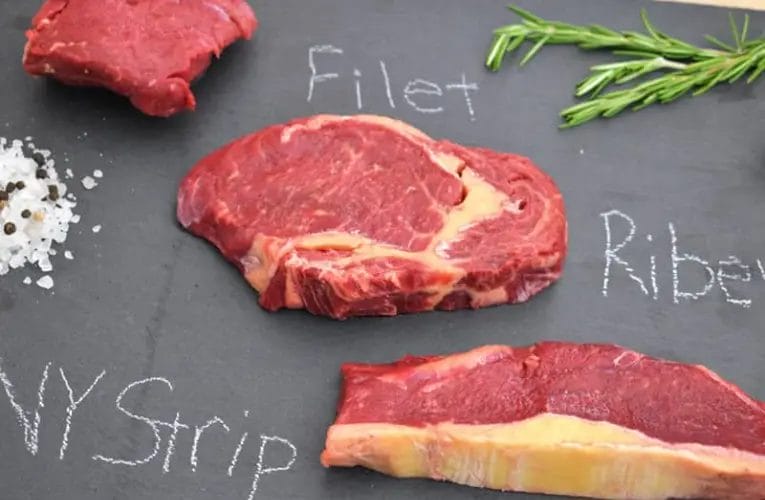Bison steak is a flavorful and lean alternative to traditional beef steak. The rich, meaty taste and tender texture make it a popular choice for steak lovers. If you’re wondering how to cook bison steak to perfection, we have got you covered.
In this guide, we will walk you through the steps to achieve a deliciously juicy and perfectly cooked bison steak. From choosing the right cut to seasoning and grilling techniques, you’ll be able to impress your taste buds with a mouthwatering bison steak at home.

Grilling Techniques for Juicy Bison Steak
Grilling a bison steak can be a real treat for meat lovers. Bison meat is lean, flavorful, and packed with nutrients. However, due to its low fat content, it requires some special grilling techniques to ensure it stays juicy and tender.
In this section, we will discuss the best grilling techniques to achieve a perfectly cooked, juicy bison steak.
1. Choose the Right Cut of Bison Steak
The first step in grilling a juicy bison steak is selecting the right cut. Some of the most popular cuts of bison steak include ribeye, striploin, and tenderloin. These cuts are known for their tenderness and rich flavor.
When choosing a cut, look for marbling – small streaks of fat running through the meat, as this will help enhance the juiciness and flavor of the steak.
2. Preparing the Bison Steak
Prior to grilling, it is essential to properly prepare the bison steak. Start by allowing the steak to come to room temperature, as this ensures even cooking.
Season the steak generously with salt, pepper, and any other desired spices or marinades. Let the steak sit for at least 30 minutes to allow the flavors to penetrate the meat.
3. Preheating the Grill
A properly preheated grill is crucial for achieving a juicy bison steak. Start by cleaning the grill grates and preheating the grill to medium-high heat.
This allows for a good sear on the outside of the steak while maintaining a juicy interior. You can also oil the grates slightly to prevent sticking.
4. Grilling the Bison Steak
When placing the bison steak on the grill, make sure to position it diagonally across the grill grates to create distinct grill marks.
Close the lid and allow the steak to cook undisturbed for a few minutes, depending on the desired level of doneness. For a medium-rare steak, a general guideline is about 4-5 minutes per side.
During the grilling process, it is important to resist the temptation to continuously flip the steak. Flipping the steak only once allows for proper caramelization and enhances the juiciness.
Use a meat thermometer to check the internal temperature for desired doneness. Bison steak is best enjoyed medium-rare to medium, with an internal temperature between 130-140°F.
5. Resting and Slicing
After grilling, it is crucial to let the bison steak rest for a few minutes before slicing. This allows the juices to redistribute, resulting in a juicier steak.
Tent the steak loosely with aluminum foil and let it rest for about 5-10 minutes. Slice the steak against the grain to ensure maximum tenderness.
6. Serving and Enjoying
Once the bison steak is rested and sliced, it is time to serve and enjoy. Pair the juicy steak with your favorite side dishes, such as roasted vegetables, mashed potatoes, or a fresh salad. The natural flavors and tenderness of the bison meat will shine through with every bite.
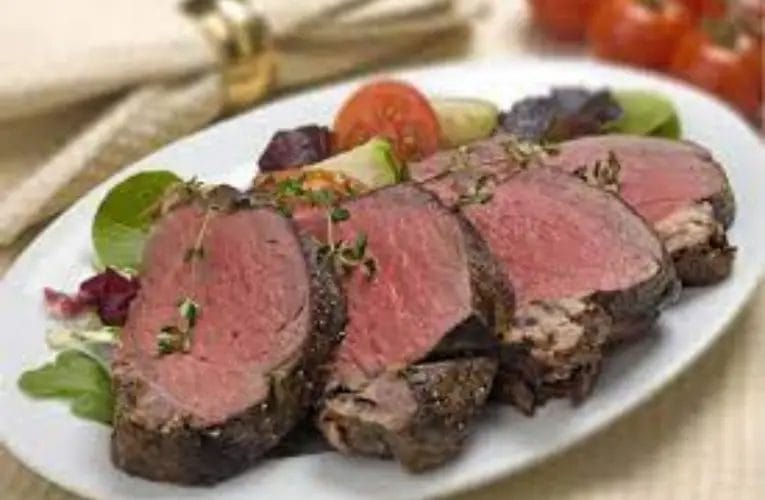
Top Marinades for Enhancing the Flavor of Bison Steak
Marinating bison steak is an excellent way to tenderize the meat and infuse it with flavors that complement its rich and lean nature. Whether you are grilling, pan-searing, or baking bison steak, a well-chosen marinade can take your dish to the next level.
In this section, we will explore some of the top marinades that can enhance the flavor of bison steak.
1. Classic Herb and Garlic Marinade
This marinade is a classic choice for any type of steak, including bison. The combination of fresh herbs, garlic, and tangy ingredients creates a robust and savory flavor profile that pairs well with the natural richness of bison meat.
To make the marinade, mix together minced garlic, chopped fresh herbs such as rosemary, thyme, and parsley, extra virgin olive oil, balsamic vinegar, salt, and black pepper. Allow the bison steak to marinate in this mixture for at least 2 hours or overnight for maximum flavor.
2. Asian-inspired Soy and Ginger Marinade
If you are looking for a marinade that adds an Asian twist to your bison steak, this soy and ginger marinade is perfect. The combination of soy sauce, grated ginger, garlic, honey, and sesame oil creates a delicious blend of sweet and savory flavors.
Simply combine these ingredients in a bowl and let the bison steak marinate for at least 4 hours. The longer you marinate, the more pronounced the flavors will be.
3. Smoky Chipotle and Lime Marinade
This marinade adds a smoky and tangy kick to bison steak, making it ideal for those who enjoy bold flavors. To make the marinade, blend together chipotle peppers in adobo sauce, fresh lime juice, minced garlic, cumin, smoked paprika, salt, and olive oil.
Coat the bison steak with this mixture and let it marinate for a minimum of 3 hours to infuse the flavors into the meat.
4. Red Wine and Herb Marinade
A rich and aromatic marinade, combining red wine and herbs, can elevate the flavor of bison steak. Mix together red wine, minced garlic, chopped fresh herbs such as thyme, rosemary, and oregano, olive oil, balsamic vinegar, salt, and black pepper.
Let the bison steak soak in this marinade for 4 to 6 hours, allowing the meat to absorb the flavors and become tender.
5. Citrus and Herb Marinade
If you prefer a lighter and refreshing flavor profile, a citrus and herb marinade can be a fantastic choice for bison steak. Combine fresh citrus juice (such as orange, lemon, or lime), minced garlic, chopped fresh herbs like basil and parsley, extra virgin olive oil, honey, salt, and black pepper.
Allow the bison steak to marinate in this mixture for at least 2 hours, allowing the citrus and herbs to infuse their flavors into the meat.
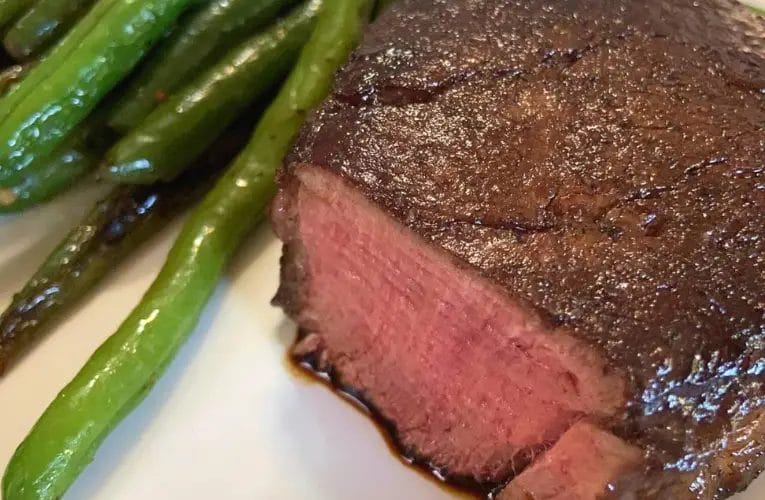
Oven-baked bison steak recipes for tender meat
Are you looking for a delicious and healthy alternative to traditional beef steak? Look no further than oven-baked bison steak! Bison meat is leaner and lower in fat than beef, making it a healthier option for those watching their diet.
Not only is bison meat nutritious, but it is also incredibly tender and flavorful when cooked properly. In this section, we will explore some mouthwatering oven-baked bison steak recipes that will leave you craving for more.
1. Classic Herb-Rubbed Bison Steak
This recipe is perfect for those who appreciate the natural flavors of bison meat. Start by preheating your oven to 400°F (200°C). Pat the bison steak dry with a paper towel and season it generously with a mixture of dried herbs like rosemary, thyme, and oregano, along with salt and pepper.
Heat a cast-iron skillet over medium-high heat and sear the steak on both sides until browned. Transfer the skillet to the preheated oven and cook for about 10-12 minutes for medium-rare, or adjust the cooking time according to your preference. Let the steak rest for a few minutes before slicing and serving.
2. Garlic and Herb Marinated Bison Steak
If you’re a fan of bold flavors, this garlic and herb marinated bison steak recipe is sure to impress. Create a marinade by combining minced garlic, fresh herbs like thyme and rosemary, olive oil, soy sauce, and a splash of balsamic vinegar. Place the bison steak in a ziplock bag and pour the marinade over it.
Seal the bag and refrigerate for at least 2 hours, or overnight for maximum flavor. Preheat your oven to 375°F (190°C). Remove the steak from the marinade and discard any excess liquid. Cook the steak in a hot skillet over medium-high heat for a couple of minutes per side to get a nice sear.
Transfer the skillet to the oven and bake for about 15-20 minutes, or until cooked to your desired doneness. Allow the steak to rest before slicing and serving.
3. Red Wine and Mushroom Bison Steak
This recipe takes bison steak to a whole new level by incorporating rich flavors of red wine and mushrooms. Start by seasoning the bison steak with salt and pepper. Heat a skillet over medium-high heat and sear the steak on both sides until browned.
Remove the steak from the skillet and set it aside. In the same skillet, add chopped mushrooms and sauté until they release their moisture and start to brown. Deglaze the skillet with red wine, scraping up any browned bits from the bottom.
Allow the wine to reduce slightly before returning the steak to the skillet. Transfer the skillet to a preheated oven and bake for about 10-15 minutes, or until the steak reaches your desired level of doneness. Let the steak rest before slicing and serving alongside the delicious mushroom and wine sauce.
4. Spicy Cajun Bison Steak
If you’re in the mood for some heat, this spicy Cajun bison steak recipe is the perfect choice. Begin by creating a Cajun spice rub with a mixture of paprika, cayenne pepper, garlic powder, onion powder, dried thyme, and salt. Rub the spice mixture all over the bison steak, ensuring it is evenly coated.
Preheat your oven to 425°F (220°C). Heat a skillet over high heat and sear the steak for a couple of minutes per side to develop a nice crust. Transfer the skillet to the oven and bake for about 8-10 minutes for medium-rare, or adjust the cooking time according to your preference.
Allow the steak to rest before slicing and serving with a side of creamy mashed potatoes or grilled vegetables.
Searing Bison Steak to Perfection on a Stovetop
If you are a fan of juicy and flavorful bison steak, then learning how to sear it to perfection on a stovetop is a must. Searing is a cooking technique that involves browning the surface of the meat at a high temperature to enhance its flavor and create a delicious crust.
In this section, we will guide you through the process of searing bison steak on a stovetop, ensuring that you achieve a mouthwatering result every time.
1. Choose the Right Cut
Before you start searing your bison steak, it is important to choose the right cut. Opt for thick-cut steaks, as they tend to sear better and retain juiciness. Bison ribeye, striploin, or tenderloin are popular choices for searing due to their tenderness and rich flavor.
2. Season the Steak
Prior to searing, season your bison steak generously with salt and pepper to enhance its natural flavors. You can also add other seasonings such as garlic powder, rosemary, or thyme, depending on your taste preferences. Ensure that the steak is properly coated with the seasoning on all sides.
3. Allow the Steak to Reach Room Temperature
Before searing, it is important to let the bison steak come to room temperature. This allows for more even cooking throughout the steak and ensures a tender result. Take the steak out of the refrigerator and let it sit on the counter for about 30 minutes to an hour.
4. Preheat a Skillet
Place a heavy-bottomed skillet or cast-iron pan over medium-high heat. Preheating the skillet is crucial for achieving a good sear on the bison steak. Ensure that the skillet is hot before adding the steak.
5. Sear the Bison Steak
Once the skillet is hot, carefully place the seasoned bison steak into the pan. Allow it to sear undisturbed for about 3-4 minutes on each side. This will create a beautiful crust on the outside while keeping the inside juicy and tender.
6. Check for Doneness
Use a meat thermometer to check the internal temperature of the bison steak. For a medium-rare result, the thermometer should read around 130°F (54°C).
Keep in mind that the steak will continue to cook as it rests, so it is advisable to remove it from the skillet when it is a few degrees below your desired doneness.
7. Let the Bison Steak Rest
After searing, transfer the bison steak to a cutting board and let it rest for about 5-10 minutes. This allows the juices to redistribute throughout the meat, resulting in a more tender and flavorful steak.
8. Slice and Serve
Once the bison steak has rested, it is time to slice and serve. Use a sharp knife to cut the steak against the grain into thin slices. This helps to maximize tenderness. Serve the seared bison steak with your favorite sides or sauces for a mouthwatering meal.
Mastering the art of searing bison steak on a stovetop can elevate your cooking skills and impress your guests. With the right cut, proper seasoning, and careful searing, you can enjoy a tender and flavorful bison steak that is cooked to perfection.
So, fire up your stovetop and get ready to indulge in a delicious seared bison steak!
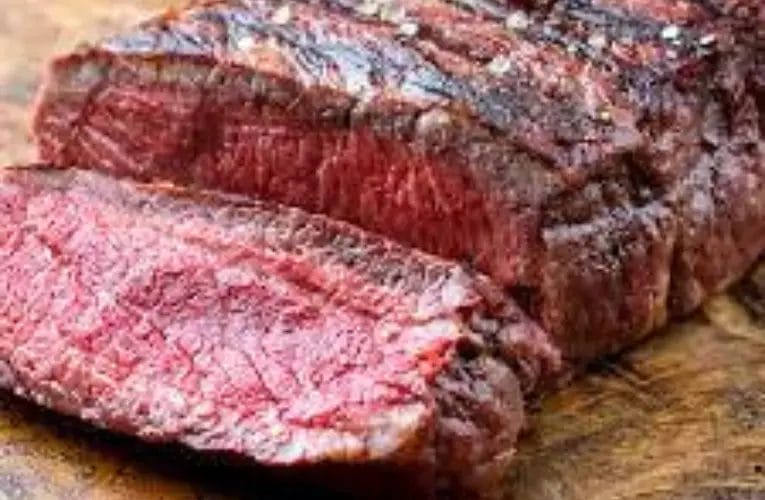
Unique Ways to Season and Flavor Bison Steak
Bison steak is a lean and flavorful alternative to traditional beef steak. With its rich, meaty flavor, bison can be seasoned and flavored in a variety of unique ways to enhance its taste.
Whether you prefer bold and spicy flavors or a more subtle and herbaceous profile, there are plenty of options to experiment with. In this section, we will explore some creative ways to season and flavor bison steak to create a truly memorable dining experience.
1. Coffee Rub
The combination of coffee and bison may seem unexpected, but the earthy and slightly bitter notes of coffee can beautifully complement the natural flavors of the meat.
To create a coffee rub, mix together freshly ground coffee beans, brown sugar, smoked paprika, salt, black pepper, and garlic powder. Rub the mixture onto the steak and let it marinate for at least an hour before grilling or searing.
2. Chimichurri Sauce
Chimichurri is a tangy and vibrant Argentinian sauce that adds a burst of flavor to grilled meats. To make a bison steak truly shine, prepare a chimichurri sauce by blending together fresh parsley, cilantro, garlic, red wine vinegar, olive oil, red pepper flakes, and salt.
Drizzle the sauce over the cooked steak or use it as a marinade to infuse the meat with its zesty flavors.
3. Maple Glaze
For a touch of sweetness, consider adding a maple glaze to your bison steak. In a small saucepan, combine maple syrup, Dijon mustard, soy sauce, garlic powder, and a pinch of cayenne pepper.
Simmer the mixture until it thickens slightly, then brush it onto the steak while grilling or searing. The maple glaze will caramelize and create a deliciously sticky coating on the meat.
4. Herb Butter
To add richness and depth of flavor, herb butter is an excellent choice for seasoning bison steak. Mix together softened butter, minced garlic, chopped fresh herbs like rosemary, thyme, and parsley, along with a squeeze of lemon juice.
Roll the butter mixture into a log using plastic wrap and refrigerate until firm. Slice a pat of herb butter and place it on top of the cooked steak to melt and infuse it with luscious flavors.
5. Smoky Spice Rub
If you enjoy smoky flavors, a spice rub with a hint of heat can elevate your bison steak. Combine smoked paprika, cumin, chili powder, garlic powder, onion powder, salt, and black pepper to create a flavorful rub.
Massage the spice mixture onto the steak and let it sit for at least 30 minutes before cooking. The smoky aroma and well-balanced heat will enhance the natural taste of the bison.
6. Red Wine Reduction
A rich and velvety red wine reduction can add elegance to a bison steak. In a saucepan, simmer red wine, beef broth, shallots, and a sprig of fresh thyme until it reduces and thickens.
Strain the sauce to remove any solids, then drizzle it over the cooked steak. The concentrated flavors of the red wine reduction will complement the hearty flavors of the bison.
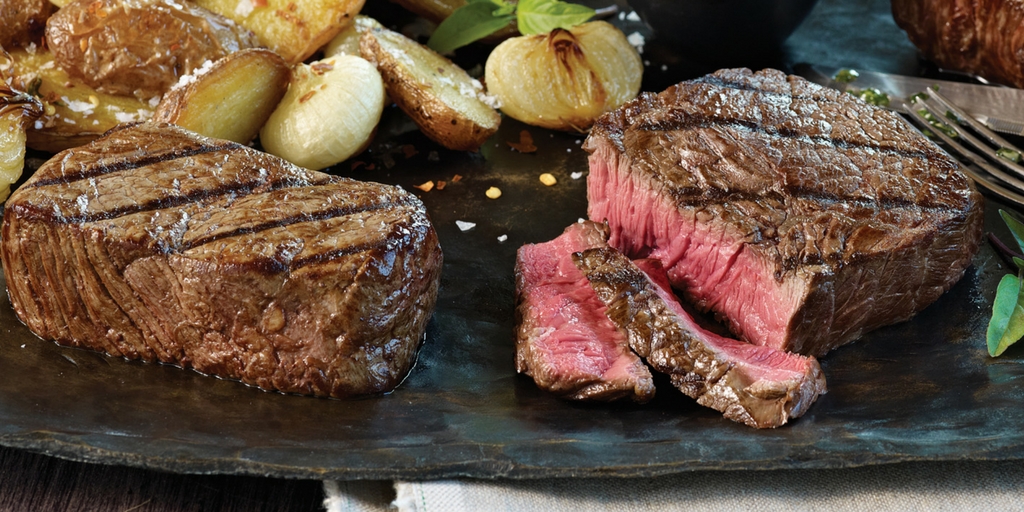
FAQs
1. How do I cook bison steak?
To cook bison steak, preheat your grill or pan to high heat. Season the steak with salt and pepper or your preferred seasoning.
Place the steak on the hot grill or pan and cook for about 4-5 minutes per side for medium-rare, or adjust the cooking time to your desired doneness. Allow the steak to rest for a few minutes before serving.
2. What temperature should I cook bison steak?
For best results, cook bison steak to an internal temperature of 130°F to 140°F for medium-rare. Use a meat thermometer to check the doneness and ensure that the steak is cooked to your preference.
3. How should I store leftover cooked bison steak?
If you have leftover cooked bison steak, let it cool down to room temperature and then store it in an airtight container in the refrigerator. It can be kept for up to 3-4 days. When reheating, make sure to do so gently to prevent overcooking and drying out the steak.
Conclusion:
In conclusion, cooking bison steak is a delightful experience that can elevate your culinary skills. Whether you prefer a tender and juicy medium-rare or a well-done steak, mastering the art of cooking bison requires precision and patience.
By following the steps mentioned earlier, you can create a mouthwatering dish that is leaner and more flavorful than traditional beef. With its unique taste and nutritional benefits, bison steak is bound to impress your guests and provide a memorable dining experience.
So, next time you’re looking to indulge in a high-quality, protein-rich meal, consider cooking up a delicious bison steak!

